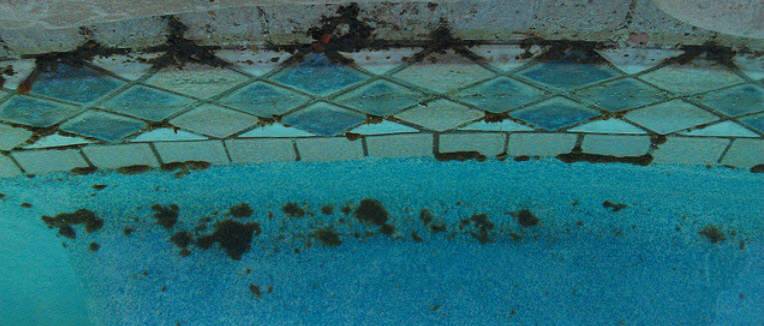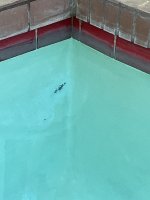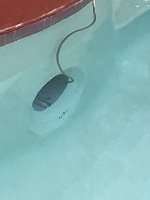I have a very stubborn case of Black algae (Cyanobacteria)that I haven’t been able to get rid of following the TFP recommendations. My 27,000 gal gunite pool is 20 years old and I suspect this Black algae has been in the pool for years and not treated. ( we lived out of country during this time). The mustard algae was taken care of but even after two weeks with an elevated FC level, daily wire brushing the Black Alage spots, and rubbing trichlor pucks over them there was very little noticeable change. I spent hours and hours besides mega money on all the liquid chlorine. I have read now that Black Algae can become resistance to Hypochlorous but that Chlorine Dioxide works. Has anyone used Chlorine Dioxide and if so where did you buy it from? Thank you
Still struggling with Black algae, Chlorine Dioxide?
- Thread starter aqua mango
- Start date
You are using an out of date browser. It may not display this or other websites correctly.
You should upgrade or use an alternative browser.
You should upgrade or use an alternative browser.
Chlorine Dioxide is a gas....not something I'd bet is easily found. And I doubt strongly its any stronger than chlorine its self. The problem with black algae is it gets inbedded in the cracks and crevices of plaster.
Is your plaster due for replacement? 20 years makes me think might be coming time?
Maddie
Is your plaster due for replacement? 20 years makes me think might be coming time?
Maddie
Katodude
Silver Supporter
- Aug 22, 2017
- 3,004
- Pool Size
- 15000
- Surface
- Plaster
- Chlorine
- Salt Water Generator
- SWG Type
- Hayward Aqua Rite (T-15)
Get a mask and snorkel.
Get a bamboo bbq skewer or some wooden sharp stick that wont damage your pool surface
Get a 1 gallon pump sprayer
Go in the water and use the wooden implement to pick at the black algae. You want to poke it and scrape as much of it off as possible. If you pool is covered in black algae then use a wire brush and scrape off as much as possible.
Then go into the pool again with the pump sprayer filled with the highest concentration of LC you can find. Spray the spots that you just disturbed.
Repeat in a few days.
Post pictures so we can tweak the advice.
Get a bamboo bbq skewer or some wooden sharp stick that wont damage your pool surface
Get a 1 gallon pump sprayer
Go in the water and use the wooden implement to pick at the black algae. You want to poke it and scrape as much of it off as possible. If you pool is covered in black algae then use a wire brush and scrape off as much as possible.
Then go into the pool again with the pump sprayer filled with the highest concentration of LC you can find. Spray the spots that you just disturbed.
Repeat in a few days.
Post pictures so we can tweak the advice.
My plaster is getting to the stage for replacement but from what I have researched most likely my Black Algae will return when my pool has been replastered due to the difficulty in killing all the very deep roots. Chlorine Dioxide can come in tab form but is very difficult to find and more expensive then regular Hypochlorous. See this link fo rmore info Chlorine Dioxide in SPA Jacuzzi pool -Chlorine Dioxide is a gas....not something I'd bet is easily found. And I doubt strongly its any stronger than chlorine its self. The problem with black algae is it gets inbedded in the cracks and crevices of plaster.
Is your plaster due for replacement? 20 years makes me think might be coming time?
Maddie
This is good advice... Thank you... I may try to get some Chlorine Dioxide to use as my solution due to its ability to penetrate the bio film. I have wire brushed the black algae out break areas and rubbed trichlor pucks on it a couple of times a day for a couple of weeks without improvement. I do believe my black algae is now resistant to most chlorine. see this info on chlorine Dioxide. Someone somewhere most of used this stuff before. I would love to hear what their experience has been using it. Chlorine Dioxide in SPA Jacuzzi pool -Get a mask and snorkel.
Get a bamboo bbq skewer or some wooden sharp stick that wont damage your pool surface
Get a 1 gallon pump sprayer
Go in the water and use the wooden implement to pick at the black algae. You want to poke it and scrape as much of it off as possible. If you pool is covered in black algae then use a wire brush and scrape off as much as possible.
Then go into the pool again with the pump sprayer filled with the highest concentration of LC you can find. Spray the spots that you just disturbed.
Repeat in a few days.
Post pictures so we can tweak the advice.
Attachments
So tell me, what scientific basis do you have for your sudden unwavering belief that chlorine dioxide will fix this problem? Black algae isn't chlorine resistant, it just digs deep in to the surface so that most of it is not exposed to chlorine. How does chlorine dioxide find success in attacking this subsurface algae when chlorine cannot?
Katodude
Silver Supporter
- Aug 22, 2017
- 3,004
- Pool Size
- 15000
- Surface
- Plaster
- Chlorine
- Salt Water Generator
- SWG Type
- Hayward Aqua Rite (T-15)
I stick by my advice. Pick at those spots with the skewer. You will see the pieces flake off. Dig at the roots.
Then with the pump sprayer dose those spots and repeat in a few days.
Then with the pump sprayer dose those spots and repeat in a few days.
- May 23, 2015
- 25,708
- Pool Size
- 16000
- Surface
- Plaster
- Chlorine
- Salt Water Generator
- SWG Type
- Pentair Intellichlor IC-60
You absolutely DO NOT want to mess with chlorine dioxide. It is seriously dangerous stuff when it is not properly handled and dosed and you could easily hurt yourself and others you love. There is reason why chlorine dioxide is not used in swimming pools and it's because of the safety hazards it poses. Yes, it can be used in large commercial pools and water treatment facilities where there are control systems in place for proper handling, injection and monitoring, but that is not your backyard pool.
Chlorine dioxide is a gas, not a solid. The solid stuff is sodium chlorite which you are expected to mix with an acid in order to generate chlorine dioxide gas. This is a very difficult thing to do in a pool and, as I said above, can lead to potential poisoning. People have died messing around with stuff (aka, "Magic Mineral Solution").
If your pool is going to be replastered then you just have to live with the black algae until it is. Do a full chip out of the paster and have the contractor chemically sanitize the concrete shell by doing an acid wash and a bleach wash. High pressure steam can also be used to sanitize concrete surfaces that have algae problems. Then the contractor can apply a new plaster layer.
Chlorine dioxide is a gas, not a solid. The solid stuff is sodium chlorite which you are expected to mix with an acid in order to generate chlorine dioxide gas. This is a very difficult thing to do in a pool and, as I said above, can lead to potential poisoning. People have died messing around with stuff (aka, "Magic Mineral Solution").
If your pool is going to be replastered then you just have to live with the black algae until it is. Do a full chip out of the paster and have the contractor chemically sanitize the concrete shell by doing an acid wash and a bleach wash. High pressure steam can also be used to sanitize concrete surfaces that have algae problems. Then the contractor can apply a new plaster layer.
This is one of the sources that I read that describes Cyanobacteria type Phormidiaceae becoming resistant to hypochlorous. Black algae in swimming pools and water featuresSo tell me, what scientific basis do you have for your sudden unwavering belief that chlorine dioxide will fix this problem? Black algae isn't chlorine resistant, it just digs deep in to the surface so that most of it is not exposed to chlorine. How does chlorine dioxide find success in attacking this subsurface algae when chlorine cannot?
I have scrubbed and scrubbed and followed TFP's regime for getting rid of Black Algae and it hasn't been working. I am still a newbie and don't pretend to know much but I have been reading up on Chlorine Dioxide and have now found a couple of sites that states it removes the biofilm of the bacteria and has been used to treat cyanobacteria successfully. Isn't one of the problems in treating Black Algae is trying to penetrate the biofilm? Help me out here. . chlorine dioxide in tablets is very very expensive and I have already spent mega dollars in treating my pool with lots of liquid chlorine following the TFP process so I don't want to waste any more money but do want to get rid of the Black Algae. There must be someone on TFPs who has tried it? This is the site that sells the Chlorine Dioxide in tablets and what it says about treating bacteria in pools and spas. Chlorine Dioxide in SPA Jacuzzi pool -
Please read this and tell me your impression...like I said I am still new to my pool's problems and don't want to spend any more money needlessly. Most appreciative. Thank you
Thank you I was hoping you would respond to my post. I will proceed as you suggest and will also use the snorkle and mask approach. Please look at this site and tell me if your opinion is any different. It seems like Chlorine Dioxide is now sold in a stable form are you aware of this? does it make any difference to your advice?. Chlorine Dioxide in SPA Jacuzzi pool -.You absolutely DO NOT want to mess with chlorine dioxide. It is seriously dangerous stuff when it is not properly handled and dosed and you could easily hurt yourself and others you love. There is reason why chlorine dioxide is not used in swimming pools and it's because of the safety hazards it poses. Yes, it can be used in large commercial pools and water treatment facilities where there are control systems in place for proper handling, injection and monitoring, but that is not your backyard pool.
Chlorine dioxide is a gas, not a solid. The solid stuff is sodium chlorite which you are expected to mix with an acid in order to generate chlorine dioxide gas. This is a very difficult thing to do in a pool and, as I said above, can lead to potential poisoning. People have died messing around with stuff (aka, "Magic Mineral Solution").
If your pool is going to be replastered then you just have to live with the black algae until it is. Do a full chip out of the paster and have the contractor chemically sanitize the concrete shell by doing an acid wash and a bleach wash. High pressure steam can also be used to sanitize concrete surfaces that have algae problems. Then the contractor can apply a new plaster layer.
Thank you again... I will proceed with your advice. is 10% hypochlorous chlorine ok to use or is there something with a higher percentage?I stick by my advice. Pick at those spots with the skewer. You will see the pieces flake off. Dig at the roots.
Then with the pump sprayer dose those spots and repeat in a few days.
- May 23, 2015
- 25,708
- Pool Size
- 16000
- Surface
- Plaster
- Chlorine
- Salt Water Generator
- SWG Type
- Pentair Intellichlor IC-60
Thank you I was hoping you would respond to my post. I will proceed as you suggest and will also use the snorkle and mask approach. Please look at this site and tell me if your opinion is any different. It seems like Chlorine Dioxide is now sold in a stable form are you aware of this? does it make any difference to your advice?. Chlorine Dioxide in SPA Jacuzzi pool -.
If you look closely at the bag you’ll see it’s exactly as I say - sodium chlorite and an “activator”. The activator is just an acid like citric acid (typical). When the tablet hits water the sodium chlorite reacts with the acid to form chlorine dioxide gas. The ClO2 dissolves in water. The process is designed to add ClO2 and then you let it naturally degrade or you add sodium hypochlorite (bleach) to consume the ClO2. It is a very powerful oxidizer and disinfectant but that also makes it more dangerous to handle. If those tablets got wet accidentally they could release toxic quantities of ClO2 gas. ClO2 can also explosively decompose in the presence of other organic and oxidizers. To use it properly you just keep ClO2 levels at or below 2ppm and the ClO2 levels should be below 0.2ppm (preferrably zero) when swimming. There are test kits that can measure ClO2 separate from chlorine.
It’s really not something you want to mess with. It’s use in hot tubs is only necessary in a public setting where multiple bathers of unknown health status would be in the water. And it’s not something you’d ever use while bathers are present.
A good stiff brushing will disrupt biofilm and let chlorine get at the algae.
- May 23, 2015
- 25,708
- Pool Size
- 16000
- Surface
- Plaster
- Chlorine
- Salt Water Generator
- SWG Type
- Pentair Intellichlor IC-60
So if you do the math, each of those tablets produces 1 gram of chlorine dioxide. Assuming it all gets dissolved, an entire bag is 50 grams. In your pool volume, the entire bag would only add ~ 0.5ppm ClO2. You would need at least 2-3ppm to treat the black algae and maintain that concentration until the BA is gone. That means you would need 4-6 bags to start plus however much you would need to add daily to maintain. At $30/bag, you’re in for $120-$180 just to start off (not to mention the cost of a proper test kit).
I don’t see how that is saving you any money.
I don’t see how that is saving you any money.
Last edited:
- Jun 1, 2018
- 16,025
- Pool Size
- 26000
- Surface
- Vinyl
- Chlorine
- Salt Water Generator
- SWG Type
- Hayward Aqua Rite (T-15)
In looking at your PoolMath logs it doesn’t look like you are keeping your fc very high.
This article outlines that you should maintain somewhere between the high target & SLAM Process fc level for your cya based on the FC/CYA Levels. Along with lots of scrubbing.

 www.troublefreepool.com
www.troublefreepool.com
This article outlines that you should maintain somewhere between the high target & SLAM Process fc level for your cya based on the FC/CYA Levels. Along with lots of scrubbing.

Black Algae
This guide provides a step by step procedure for eliminating black algae in your concrete or gunite pool. Read full post here.
Katodude
Silver Supporter
- Aug 22, 2017
- 3,004
- Pool Size
- 15000
- Surface
- Plaster
- Chlorine
- Salt Water Generator
- SWG Type
- Hayward Aqua Rite (T-15)
Thank you again... I will proceed with your advice. is 10% hypochlorous chlorine ok to use or is there something with a higher percentage?
Yes 10% is fine. Just pick at the spots and then spray. Repeat a few times if its really stubborn.
THank you for looking at the site and patiently explaining further to me about the dangerous of chlorine dioxide. I will not use that product.If you look closely at the bag you’ll see it’s exactly as I say - sodium chlorite and an “activator”. The activator is just an acid like citric acid (typical). When the tablet hits water the sodium chlorite reacts with the acid to form chlorine dioxide gas. The ClO2 dissolves in water. The process is designed to add ClO2 and then you let it naturally degrade or you add sodium hypochlorite (bleach) to consume the ClO2. It is a very powerful oxidizer and disinfectant but that also makes it more dangerous to handle. If those tablets got wet accidentally they could release toxic quantities of ClO2 gas. ClO2 can also explosively decompose in the presence of other organic and oxidizers. To use it properly you just keep ClO2 levels at or below 2ppm and the ClO2 levels should be below 0.2ppm (preferrably zero) when swimming. There are test kits that can measure ClO2 separate from chlorine.
It’s really not something you want to mess with. It’s use in hot tubs is only necessary in a public setting where multiple bathers of unknown health status would be in the water. And it’s not something you’d ever use while bathers are present.
Yes, when I was keeping my FC high after treating for Yellow Algae. I didn't note all my FC levels on my pool math page. I wasn't sure how to use the pool math page during treatment cause all I was testing was chlorine at that time. I did keep written notes and see that from Aug 1st to Aug 20th my FC level ranged from 26 FC to 22 FC. This was 19 days of high FC plus I did two phosphate treatments during this time. As well I was wirebrushing the black algae spots and breakouts and rubbing trichlor pucks over the areas a couple times a day.. very little noticeable change in the BA.In looking at your PoolMath logs it doesn’t look like you are keeping your fc very high.
This article outlines that you should maintain somewhere between the high target & SLAM Process fc level for your cya based on the FC/CYA Levels. Along with lots of scrubbing.

Black Algae
This guide provides a step by step procedure for eliminating black algae in your concrete or gunite pool. Read full post here.www.troublefreepool.com
Katodude
Silver Supporter
- Aug 22, 2017
- 3,004
- Pool Size
- 15000
- Surface
- Plaster
- Chlorine
- Salt Water Generator
- SWG Type
- Hayward Aqua Rite (T-15)
I have never found the trichlor pucks to work for me. Find whatever method works to disrupt the bio film. Wire brush, wooden pick, even a pressure washer. Then hit it with as much concentrated LC as you can. The pump sprayer works best I have found (method pioneered by @cowboycasey).
Please just do me the favor of trying this out. Then we can discuss all the rest of your ideas.
Please just do me the favor of trying this out. Then we can discuss all the rest of your ideas.
Thread Status
Hello , This thread has been inactive for over 60 days. New postings here are unlikely to be seen or responded to by other members. For better visibility, consider Starting A New Thread.




